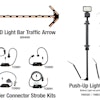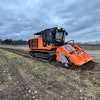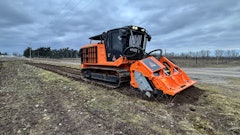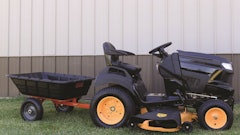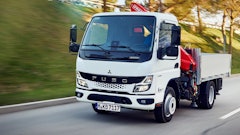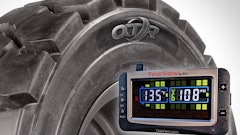
Ram says it has brought a great deal of innovation to the work truck market over the past couple of years, focusing on what contractors really need at each stage of their business and from each type of vehicle.
Light-Duty Trucks (Ram 1500). Ram points out that it was the first to introduce an eight-speed transmission into the light-duty pickup market, pairing it with a high-tech V-6 engine that gets 25 mpg. This made for a very capable, efficient vehicle for entry-level contractors. Additionally, Ram brought the eight-speed transmission to its already popular Hemi engine to improve its fuel economy.
"The big thing we did that really shook up the market, though, was introduce the EcoDiesel engine in a light-duty truck," says David Sowers, head of Ram Trucks marketing. "The 240-hp, 3-liter EcoDiesel gets up to 29 mpg on the highway, but is still capable of towing 9,200 pounds and has 420 lb-ft of torque."
Additionally, Ram has introduced four-corner air suspension. This allows contractors to raise/lower their truck a total of four inches. This can come in handy for off-road capability or even when loading things like seed or fertilizer into the bed. "Once the load is in there, the air suspension auto-levels," Sowers adds.
Another innovation is the lockable RamBox system which allows contractors to store things like safety gear, trimmer line, etc. in the unused space right above the wheel wells—without compromising existing bed space. You can also put dividers in the RamBox to enhance organization.
Finally, all Ram trucks now feature extended oil change intervals: 10,000 miles on gas models, 15,000 miles on diesels and pickups. This goes for not only Ram's light-duty trucks, but also its heavy-duties, chassis cabs and vans.
Heavy-Duty Trucks (Ram 2500 and 3500). Ram offers two powertrains. One is a 6.4-liter gas Hemi engine designed specifically for commercial usage. It features "Best in class" horsepower (410) and torque (429 lb-ft), and operators also have the ability to run on four cylinders when full load isn't present, which helps conserve fuel. The second powertrain is a 6.7-liter Cummins diesel engine that provides up to 900 lb-ft of torque capable of pulling very heavy loads (17,980 pounds with the Ram 2500 and 31,210 pounds with the 3500).
Ram has also added some technological innovations to its heavy-duty trucks, including coil-spring suspension on the Ram 2500 for improved ride quality and surer handling when either empty or trailering.
Fuel efficiency also remains an important consideration. "Our diesel engines now use diesel exhaust fluid as part of the emissions controls," Sowers says. "That has also given us a 25% improvement in fuel economy—and we still get that huge torque output."
One more thing to think about with heavy-duty trucks is what you might be doing with them in the off-season. "Our trucks have great snowplow capability, particularly with the 6.4-liter Hemi engine and transmission that goes with it," Sowers says. "Our stability control feature makes it very effective in snow. And we offer a Snow Plow Prep Group that allows contractors to switch their trucks from one business/season to the other without missing a beat."
Chassis Cabs (Ram 3500, 4500 and 5500 Chassis Cabs). Ram has GVW ratings of 10,000 to 14,000 pounds depending on the configuration. (GVWR is basically the weight of the truck and everything in it, excluding any trailer it might be pulling.)
"You might wonder why a contractor would want a 10,000-GVWR truck, as opposed to the extra capacity of 14,000 pounds," Sowers muses. "A 10,000-pound truck helps the business avoid certain restrictions on travel (i.e. certain bridges and urban areas) as well as licensing requirements for drivers. That's a big deal when it's challenging to find good employees."
Contractors should also think about flexibility with a chassis cab. "You want a truck that is upfitter-friendly," Sowers points out. "We have industry-standard 34-inch-wide frame rails, and the top of the frame rail is very clean so no equipment sticks above it. We route our fuel filler through the frame, which leads to less expense when upfitting. Also, the diesel exhaust fluid fill is tucked up against the back of the cab so the upfitter doesn't have to do anything with that either. And because everything is industry-standard, a contractor can easily switch things over (like a dump insert) from truck to truck if he needs to."
Ram's ProMaster City is a Class 1 van, which Sowers says is a fairly new, but growing segment. "It provides up to 131 cubic feet of storage, gets up to 29 mpg on the highway, and has a payload of 1,883 pounds. So it's a very capable, efficient little van. It's great for getting in and out of tight places."
Ram also offers its full-size ProMaster van in a number of configurations via 15 models offering three wheelbases, four lengths and two roof heights. "Between all of the options, a contractor can get exactly what he needs with this van," Sowers assures.
A 65-inch interior roof height is standard, thanks in part to the van's front-wheel drive, which is industry-unique for a full-size van. "This also allows us to get really good wheel cut in the front, which allows for a really tight turning radius," Sowers explains. "We also achieve excellent traction, even when the van is empty. And it allows us to lower the load floor in the back because we don't have prop shafts going back there. We have the lowest load-in height (21 inches), which really helps if contractors have to get in and out of the back quite a bit. That feature also helps if you want to put a ramp on to load equipment into the back."

